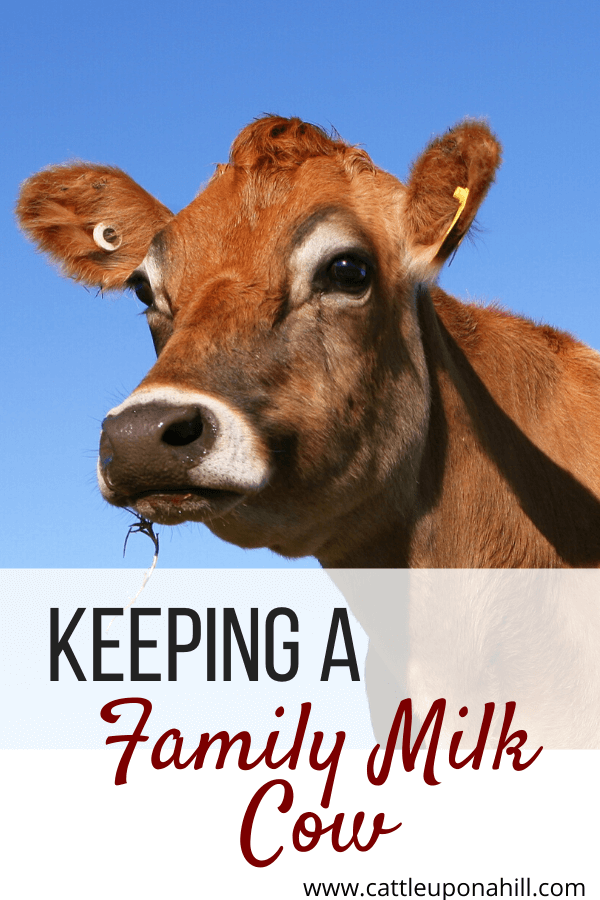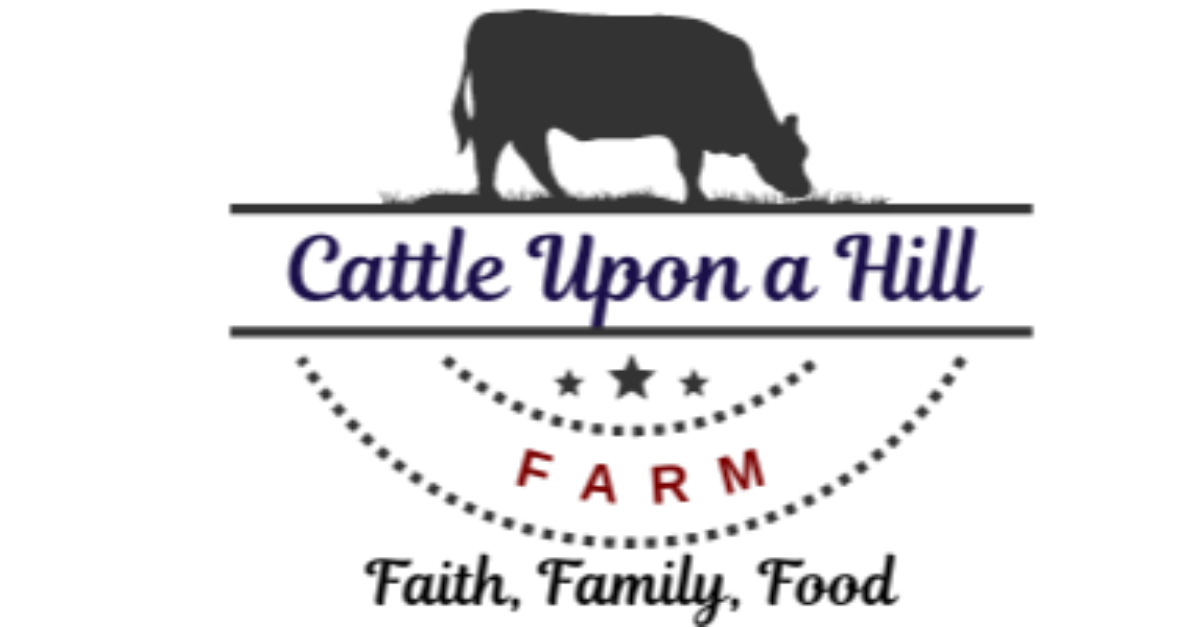Buying a Family Milk Cow? - 5 Questions to Ask
Keeping a family milk cow is a wonderful step to building self-sufficiency, but it is a big step! Before jumping right in, you should consider the purpose of keeping a milk cow, the costs, the advantages, the disadvantages, and special considerations. Download the FREE self-sufficiency workbook from my 5-day Farm Animal Challenge to decide if owning a milk cow is right for you!
When I first moved to the farm after I married my husband, my mother-in-law had been milking a cow her whole life! I had never drunk fresh, raw milk! I was nervous at first because I didn't even know how to skim the cream off of the milk or that it was even necessary. (It's really not, but I prefer the milk skimmed.) Once I tried the sweet, fresh milk from the cow, I was hooked! Then I learned all the dairy products that I could make: yogurt, butter, kefir, ice cream, buttermilk, etc! This definitely was a huge step in my self-reliant journey! Read on to see if a milk cow would be a good self-sufficiency step for you and your family.

What is the purpose of keeping a Milk Cow?
The most obvious reason for keeping a milk cow is to build self-sufficiency by producing your own milk on the farm.
Your milk cow will produce gallons and gallons of delicious, healthy milk and heavy cream.
Besides drinking the milk, you can make a variety of dairy products including
- butter
- yogurt
- buttermilk
- kefir
- sour cream
- whey
- cottage cheese
- soft and hard cheeses
- ice cream
- cream cheese
- . . . just to name a few.
You will find that your cow produces so much milk that you will need to find creative ways to use all the milk if you are unable to sell it off your farm.
If you are blessed to live in a state where you can sell your extra raw milk from your homestead, then keeping a milk cow can be profitable. You can acquire customers who will come to your farm to pick up milk on a weekly basis. I live in a state where it is illegal to sell milk off the farm.
There were farmers who tried to get around the law by selling shares of the cow to customers, but that was also deemed illegal and the farmer was severely punished. Please research the laws in your state before selling raw milk off the farm.
Another way to earn a profit from your cow is to sell products produced from milk such as butter, yogurt, and soap. Again, please check the regulations in your state.
You can also sell the calf that your cow has. Your cow will have a calf every year. I usually raise the calf until it is weaned. If the cow has a heifer and we don't need a replacement cow, I sell her around 4-6 months of age. When it is a bull calf, I either sell it like a heifer after he has been castrated or raise it up to butcher age (around 18 months) and sell him at the sale barn, on craigslist, or butcher him and sell the meat. If we need meat, we sometimes have him butchered for our own meat.
The Cost of Keeping a Milk Cow
Food and Water
A cow needs both roughage and protein. Roughage can be supplied by pasture and various forms of hay. Good grass hay and grass pasture can contain sufficient protein for animal maintenance, however, for a lactating dairy cow, higher protein feeds such as alfalfa hay, grass-legume pasture, or protein supplements increase milk production. Mineral supplements and salt are also necessary. A milk cow can drink up to 30 gallons of water per day, so provide plenty of fresh water. This is important to consider if you must haul the water by buckets to your cow.
Shelter
You will need shelter for your milk cow. Whether that be a barn stall or other building. During rainy, muddy, or winter weather, the cow needs to be inside to prevent stress or sickness which affects her milk production and health.
Even if you live in a mild climate, you will want some sort of shelter to milk the cow. In addition to shelter, you will need a stanchion to restrain the cow during milking. There are many DIY plans available. My friends over at FlipFlop Barn Yard have a great step-by-step plan. We have a tie stanchion for our milk cow.
Bedding
While inside, cows need fresh straw or other bedding material to lay on. We use oat straw from the oats we produce on the farm. A rubber cow mat is optional, but it will make your cow more comfortable if you have a concrete floor in the barn.
Pasture
You can own a milk cow without a large pasture. It will just require much more hay. Even if you have a small paddock or barnyard, you can supplement hay and other roughage. When purchasing a milk cow, you may want to ask if she has been an electric fence trained. If she does respect the electric fence, you can fence off areas of your property and rotate her pasture.
Veterinarian Care and Insemination Costs
You will want to give your cow vaccines on an annual basis. Unless you have a bull, you will also need to have her bred on an annual basis. Both of these costs vary depending on where you live.
Milking Equipment
Milking by Hand versus a Milking Machine
Obviously, you can milk your cow by hand, but I think you will find that it is a very tedious job. You are going to really, really want fresh milk to hand milk. I have never personally milked a cow by hand. I know that many homesteaders milk by hand so it is certainly possible. You will develop very strong hands and fingers. However, if you have never milked a cow by hand, I suggest you try it before you purchase your own cow. Ask a friend or neighbor to allow you to milk by hand and to teach you how.

We have always had a bucket milker. A bucket milker consists of a vacuum pump, a bucket and lid, a pulsator, and a claw. The vacuum pump is connected to the bucket milker via a vacuum line. The vacuum line maintains a steady vacuum to make the pulsators suck the milk from the cow. Most bucket milkers hold 4 to 8 gallons of milk. This is plenty of room for the milk from one cow.
You will also need additional equipment including a way to strain the milk and carry the milk back to the house. There are, of course, frugal ways to do this, such as a kitchen strainer and mason jars, but if you can afford it these two options are really convenient. A large Stainless Steel Strainer with filters and a 10 Qt Stainless Steel Milk Can Tote.
The advantages of having a family cow include:
The advantages of owning a milk cow, of course, are the farm-fresh dairy products she produces for you.
- Fresh, raw milk
- Rich, delicious cream
- Homemade yogurt, kefir, cheese.
- Extra milk to feed other farm animals such as bottle calves, pigs, and chickens.
- Fertilizer for certain garden plants
- A new calf every year
Disadvantages of keeping a Milk Cow
TIME AND COMMITMENT
I think the biggest consideration when deciding on whether to keep a milk cow or not is the time and commitment it will take.
Like all mammals, a cow produces milk in order to feed its calf. After the cow has given birth, she must be milked (or her calf nurses) at least twice daily or the milk will stop flowing. A cow will produce milk for about ten months of milk. It is important to let the cow rest at least two months before a new calf is born.
The daily routine consists of feeding, watering, and milking twice a day. You may also milk once a day by separating the calf from the cow for about 12 hours before you milk. You will also need to clean the manure out of the milking area daily. Your cow will also need to be fed and watered.
You can not take the weekend off or not do it when you are sick. You must be able to commit to daily milking and have a backup plan in case of emergencies. If a cow isn’t milked daily, she may become sick, her milk production will go down and she will eventually dry up.
We have always milked our cow twice a day: morning and night. There is a milking method called once-a-day milking where you can put the calf on the cow for one milking. This may be convenient, but there are some drawbacks to this method. The cow will learn to hold her milk back for her calf and also she will not give as much milk over time. Her milk production will adjust according to the calf’s needs.
Special Considerations of Owning a Milk Cow
DAIRY COW BREEDS
Choosing the right breed will depend on your unique homestead. If you have a small homestead, I highly recommend a Jersey Cow. They are small, gentle, and produce a lot of fresh cream to make butter, ice cream, cream cheese, etc.
Are you Ready to Purchase a Milk Cow for your Homestead?
What about you? Are you ready to purchase a family milk cow? Do you already own a milk cow? What was your experience? I Be sure to join the Free 5-day Farm Animal Challenge to download the workbook and learn even more about owning a milk cow.
